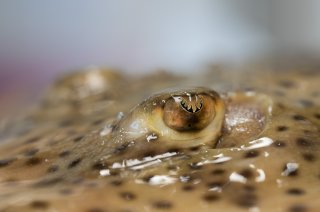
Project
Innorays: DNA kinship analysis
Can we estimate how many rays are swimming in the North Sea with DNA kinship analysis and close kin mark recapture?
Fisheries and nature management requires better data on rays
We know very little about the catch quantities and stock sizes of the different species of rays that live in the North Sea. Yet, as a long-lived species, rays form an important part of the ecosystem and are a commercially interesting bycatch in flatfish fisheries. Due to knowledge gaps about ray populations, the advice on sustainable catch quantities by the scientists of the International Council for the Exploration of the Sea (ICES) is based only on data from surveys conducted with research vessels. The population estimates therefore carry great uncertainties.
What is the core question of the research?
The key question of the research is whether a new and innovative DNA method can be used to estimate population sizes of Thornback ray (Raja clavata) and Blonde ray (Raja brachyura).
The Wageningen University Animal Breeding and Genetics department, the Aquaculture and Fisheries department, and Wageningen Marine Research answer these questions in close collaboration with the project partners from the Dutch fishing industry: VisNed and Nederlandse Vissersbond. With the results of the project, we improve the knowledge base for the management of rays and lay a foundation for using this method to assess other stocks in the future.
The research is part of a larger project. In addition to the use of DNA techniques, Wageningen University and Research also investigates whether we can improve the population estimates with video images.
Collecting DNA
In the sampling for the kinship analysis, we collect DNA material from 2000 Thornback rays and 1000 Blonde rays. We do this by making a cut in the tail fin of the ray. In addition, we note the length and sex of each sampled ray.
Part of the DNA samples come from catches in the fishery and is collected from fish auctions. We also collect vertebrae from these dead animals, which we use to read annual growth rings. This technique has potential to determine the age of the rays. Other DNA samples are collected on research vessels and fishing vessels during ongoing fish stock research. These animals are returned to the sea after the catch and analysis, which means that we can only collect DNA material and no vertebrae. With this combination of data collection methods, we can take sufficient samples with the largest possible spatial coverage.
Kinship analysis
New genetic techniques make it possible to determine the relationship between sampled individual rays. We determine this relationship by analysing a large number of Single Nucleotide Polymorphisms (SNPs). Such SNPs are different from one DNA base pair, and are spread across the genome. An analysis of these differences can show whether captured animals form parent-child pairs, or whether they are, for example, half-brothers or half-sisters. During the project, we will also try to unravel further family relationships, as this may increase the power of expression of the method over the population sizes.
Population estimation
We make a population estimate based on the relationship in the samples. We do this with the help of close-kin mark-recapture. This method first compares all possible pairs in the sampled animals to see if there are any relationships. The larger the real population, the smaller the chance that two random animals from our sample are related to each other. The next step is to draw up a model of the ray population. This model takes into account the gender, length, and age of each animal and provides expectations of the kinships depending on the population size. The last step is a comparison between the found and the expected kinships. The most likely population size is where the differences between the expected and the found kinships are the smallest. This ultimately yields the population estimate, which is the goal of the project.
Animal Experimentation Act
For this project, a permit has been issued under the Dutch Animal Experimentation Act, as approved by ethical committees (Experiment 2018.D-0006.001).